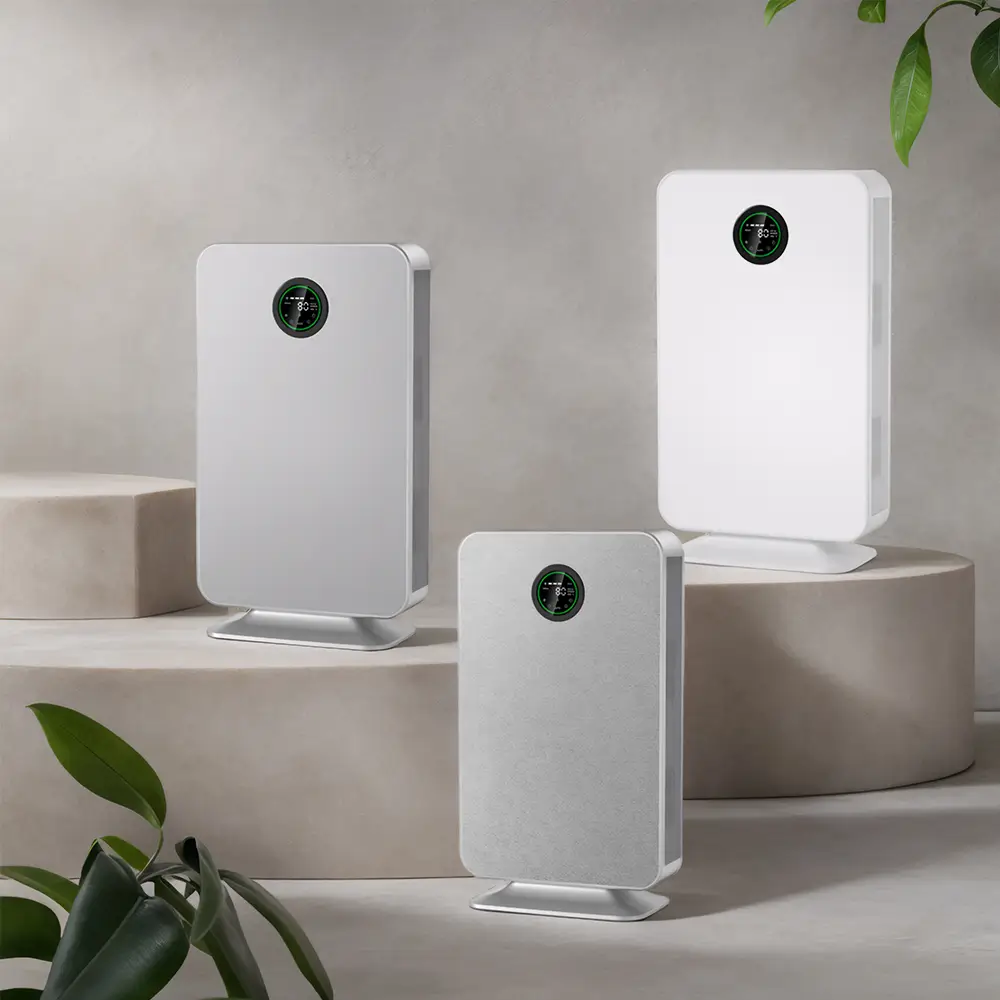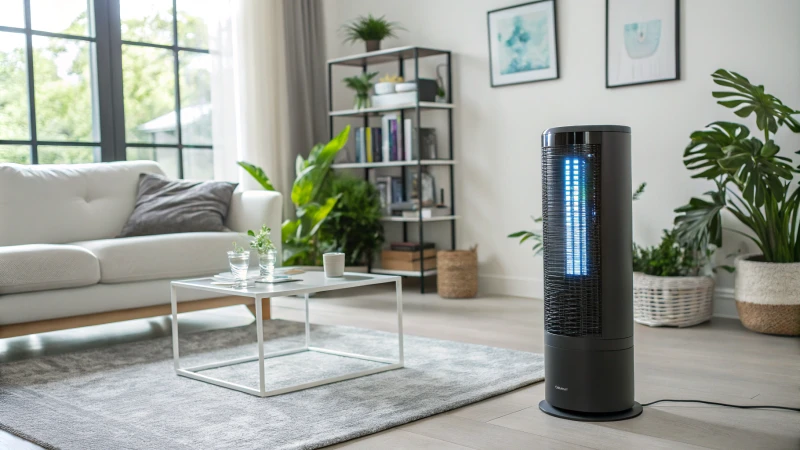
공기청정기의 성능을 높이는 방법에 대해 생각해 본 적이 있나요?
HEPA 필터는 작은 입자를 걸러냅니다. 활성탄은 냄새를 제거합니다. UV-C 빛은 세균을 죽입니다. 각각 중요한 역할을 합니다. 함께 실내 공기를 정화합니다. 최상의 결과를 얻으려면 안전하고 올바르게 사용하는 것이 중요합니다. 안전은 정말 중요합니다.
공기 정화 분야에서 일했던 시간을 돌이켜보면 각 기술이 공기 정화에 얼마나 중요한 역할을 하는지 알 수 있습니다. 공기청정기 하나만으로는 충분하지 않으며 각 부품이 어떻게 함께 작동하는지 아는 것이 핵심입니다. 처음 이 시스템에서 일할 때는 모든 조각이 중요한 퍼즐을 푸는 기분이었습니다.
공기청정기를 업그레이드할 계획이거나 현재 사용 중인 공기청정기를 최대한 활용하고 싶다면 이러한 기술을 안전하게 혼합하는 방법을 아는 것이 매우 중요합니다. 다음 편에서는 현명한 선택을 돕기 위해 제 경험에서 얻은 팁을 공유하겠습니다. 여기에는 다음 사항을 확인하는 것이 포함됩니다. HEPA 필터를 올바르게 적용하고 다음과 같은 장단점에 대해 생각해보십시오. UV-C 조명. 제 목표는 공기 정화를 올바르게 설정할 수 있도록 안내하는 것입니다.
HEPA 필터는 공기 중 입자를 효과적으로 포집합니다.True
HEPA 필터는 0.3마이크론 크기의 입자를 99.97%까지 포집하도록 설계되었습니다.
UV-C 광선은 공기청정기의 바이러스에는 효과가 없습니다.False
UV-C 광선은 바이러스의 DNA를 손상시켜 복제를 방지함으로써 바이러스를 무력화할 수 있습니다.
사용 이유 HEPA 활성탄 필터를 함께 사용하시나요?
공기는 안전하니 안심하세요! 다음의 조합 HEPA 활성탄 필터를 사용하는 것은 단순히 현명한 결정일 뿐만 아니라 집안 공기 질에 큰 변화를 가져올 수 있습니다.
HEPA 와 활성탄 필터를 함께 사용하면 공기 정화 효과가 뛰어납니다. HEPA 필터는 먼지와 알레르겐을 걸러냅니다. 활성탄은 냄새와 휘발성 유기 화합물(VOC)을 제거합니다. 이 조합으로 실내 공간이 더 깨끗해집니다. 공기가 더 상쾌하게 느껴집니다.

이해 HEPA 및 활성탄 필터
매우 신선한 느낌의 방에 들어섰다고 상상해 보세요. HEPA (고효율 미립자 공기) 필터와 활성탄 필터가 집안에서 이러한 경험을 선사합니다. 두 가지를 모두 처음 사용했을 때 공기가 정말 맑게 느껴졌습니다.
HEPA 필터는 경비원처럼 작동하여 다음과 같은 원치 않는 게스트를 차단합니다. 먼지, 꽃가루, 애완동물의 비듬1및 곰팡이 포자. 이 필터는 0.3마이크론의 작은 입자를 99.97% 이상 포집합니다. 반면 활성탄 필터는 오염 물질이 탄소 표면에 달라붙는 흡착 과정을 통해 가스, 화학 물질 및 냄새를 포집하는 데 탁월합니다.
이중 필터링의 시너지 효과
이 두 가지가 함께 작동할 때 진정한 마법이 일어납니다. 공기에 알레르기 유발 물질과 악취가 없는 곳에서 생활한다고 상상해 보세요. 어젯밤의 저녁 식사 냄새나 담배 연기는 입자상 물질과 가스 오염 물질을 모두 제거하는 이 조합으로 사라집니다.
| 필터 유형 | 목표 오염 물질 |
|---|---|
| HEPA 필터 | 먼지, 꽃가루, 애완동물의 비듬, 곰팡이 포자 |
| 활성탄 | 냄새, VOC(휘발성 유기 화합물2), 화학 증기 |
이러한 필터를 함께 사용하면 인스타그램에서 편집한 사진처럼 선명한 공기를 만들 수 있습니다.
수명 및 효율성 향상
두 필터를 모두 사용하면 공기질을 개선하고 공기청정기를 더 오래 사용할 수 있습니다. 그리고 HEPA 필터는 입자에 대한 주요 방어 수단으로, 큰 오염 물질은 활성탄 필터가 먼저 걸러내어 HEPA 막힘 없이 작업에 집중할 수 있습니다.
필요에 따라 필터를 청소하거나 교체하는 등 정기적인 관리가 중요하며, 이를 통해 많은 문제를 예방할 수 있습니다. 자동차의 오일을 교환하는 것과 같은 이치입니다. 정기적인 유지보수는 다음과 같은 제조업체에서 권장하는 대로 최적의 성능을 보장합니다. HisoAir3.
실제 애플리케이션
반려동물을 키우거나 흡연자와 함께 사는 경우 깨끗한 공기가 매우 중요합니다. 천식이 있는 제 친구들은 저희 집을 방문하면 항상 숨쉬기가 얼마나 편한지 이야기합니다.
호텔이나 병원과 같은 사업장에서는 깨끗한 공기가 매우 중요합니다. 고객의 만족도를 높일 뿐만 아니라 건강 문제를 유발하는 자극 물질을 줄여 생산성을 높일 수도 있습니다.
더 많은 공기 정화 솔루션 살펴보기4 를 통해 실내 공간이 항상 신선하고 따뜻한 느낌을 줄 수 있도록 적합한 시스템을 찾아보세요.
HEPA 필터는 99.97%의 입자를 포착합니다.True
HEPA 필터는 0.3마이크론 크기의 공기 중 입자를 99.97% 이상 포집하도록 설계되었습니다.
활성탄 필터는 알레르기 유발 물질을 제거합니다.False
활성탄 필터는 주로 입자상 알레르기 유발 물질이 아닌 가스, 화학물질, 냄새를 포집하는 데 사용됩니다.
어떻게 UV-C 공기청정기에 조명이 작동하는데 안전한가요?
궁금한 점이 있으신가요? UV-C 공기청정기의 빛이 비밀리에 세균으로부터 집을 보호할 수 있을까요? 이 기술이 어떻게 작동하는지, 도움이 되는지 해로운지 알아보세요.
UV-C 공기청정기의 빛은 자외선을 사용하여 공기 중 세균의 DNA를 파괴합니다. 이 작용은 바이러스와 박테리아를 죽입니다. 안전한 사용이 매우 필요합니다. 자외선 노출과 오존 발생은 위험할 수 있습니다.

이해 UV-C 기술
저는 다음과 같은 내용을 배웠던 기억이 납니다. UV-C 기술. 마치 비밀스러운 초능력을 발견한 것 같았습니다. UV-C 빛200~280 나노미터 파장을 가진 광선은 세균의 DNA를 비활성화하여 바이러스 및 박테리아5. 따라서 공기 정화에 흥미를 느낄 수 있습니다.
공기청정기의 경우, UV-C 램프는 특별한 위치에 있습니다. 그 사이로 공기가 흐르며 세균을 가둡니다. 일부 모델은 자외선으로 모든 미생물을 잡기 위해 반짝이는 표면을 사용하기도 합니다.
안전 문제 및 솔루션
하지만 모든 초능력이 그렇듯 단점도 있습니다. 제가 엔지니어라서 그런지 항상 안전에 신경을 씁니다. UV-C 빛 는 피부를 태우거나 눈을 다치게 할 수 있습니다. 또한 산소와 섞여 폐를 자극하는 오존을 형성할 수도 있습니다.
이 문제를 해결하기 위해 제조업체는 정수기 내부에 조명을 숨깁니다. 이렇게 하면 빛이 새지 않고 여전히 깨끗한 공기6.
| UV-C 기능 | 잠재적 위험 | 완화 전략 |
|---|---|---|
| 피부 및 눈 손상 | 자외선 직접 노출 | 밀폐형 UV 챔버 |
| 오존 생성 | 산소 상호 작용 | 오존 없는 기술 |
대안 및 권장 사항
다양한 옵션을 고려할 때 다음과 같은 생각이 듭니다. HEPA 및 활성탄 필터. 이 필터는 잘 작동하며 UV-C의 위험. 예를 들어 HEPA 14개 필터 는 오래 지속되고 오염에 강한 특별한 제품입니다.
제 경험상, 좋은 필터 재료를 사용하면 HEPA 필터를 더 오래 사용할 수 있습니다. 또한 교체 비용도 절약할 수 있습니다. 눈에 띄려면 고급 필터링7 메서드 대신 UV-C.
결국 UV-C 빛은 공기 정화에 강력하며, 그 작동 원리와 위험성을 이해하는 것이 정말 중요합니다. 이 기능이 있는 공기청정기를 선택하려면 건강을 보호하는 데 안전한지 확인해야 합니다. 실내 환경8.
공기청정기의 UV-C 광선은 모든 박테리아를 죽입니다.False
UV-C는 효과적이지만 100% 박테리아 제거를 보장하지는 않습니다.
UV-C 광선은 공기청정기에서 오존을 생성할 수 있습니다.True
UV-C는 산소와 상호작용하여 호흡기 자극 물질인 오존을 형성할 수 있습니다.
왜 HEPA 14 더 나은 공기질을 위해 권장되는 선택인가요?
나는 마법을 발견한 날을 기억합니다. HEPA 14개의 필터. 깨끗한 공기를 위한 숨겨진 보석을 발견한 기분입니다. 이 필터는 정말 공기를 정화해줍니다. 사람들이 왜 이 필터에 대해 그렇게 극찬하는지 궁금하신가요?
HEPA 14개의 필터는 0.3마이크론 크기의 입자까지 99.995%의 작은 입자를 걸러내는 것으로 유명합니다. 필터의 뛰어난 여과 능력은 매우 깨끗한 공기가 필요한 장소에 적합합니다. 알레르기가 있는 사람이 있는 병원과 가정에 큰 도움이 됩니다. 이것은 중요합니다. 이 필터는 정말 좋은 역할을 합니다.

이해 HEPA 필터링 효율성
처음 이 방법을 배웠을 때가 기억납니다. HEPA 필터가 작동합니다. 집안 공기질을 개선할 방법을 모색하던 중 이런 일이 일어났습니다. 동안 HEPA 13 필터는 99.95%의 입자를 포착합니다, HEPA 149 는 99.995%를 캡처하여 더 좋습니다. 처음에는 이 작은 차이가 작아 보이지만 매우 깨끗한 공기가 필요한 곳에서는 작은 차이도 중요합니다.
| HEPA 등급 | 효율성 |
|---|---|
| HEPA 13 | 99.95% |
| HEPA 14 | 99.995% |
의료 환경에서의 애플리케이션
병원에서 공기를 정화하는 방법을 보면서 공기질에 대한 관심이 커졌습니다. 저기 있죠, HEPA 14 필터는 바이러스나 박테리아를 보유할 수 있는 초미세 입자를 걸러내기 때문에 일반적으로 사용됩니다. 이러한 필터는 수술실과 격리 병동10.
알레르기 환자를 위한 혜택
매년 봄이 되면 알레르기가 저를 괴롭혔습니다. HEPA 14개의 필터. 꽃가루와 집먼지 진드기 같은 알레르기 유발 물질을 잡아줍니다. 알레르기 시즌에 제 삶이 많이 개선되었습니다. A 알레르기 완화에 관한 연구11 는 고급 필터가 알레르기에 큰 도움이 된다는 것을 보여줍니다.
수명 연장 및 비용 효율성
HEPA 14 필터는 먼지를 많이 흡수하는 소재와 결합하면 오래 사용할 수 있어 교체 횟수가 줄어듭니다. 따라서 비용도 절약되고 쓰레기를 줄여 지속 가능한 삶을 지향하는 저의 목표에도 도움이 됩니다.
공기청정기 고려 사항
공기청정기를 선택할 때는 필터 효율보다 더 중요한 것이 있습니다. 공기 흐름 저항과 소음 수준과 같은 요소가 사용자 경험에 영향을 미치는지 고려하세요. 일부 브랜드는 다음과 같은 기능을 제공합니다. 데시벨 캔슬레이션™12 기술을 통해 소음을 줄여 편안함을 제공합니다.
대체 기술 살펴보기
깨끗한 공기를 찾기 위해 다음과 같은 다른 방법을 찾았습니다. UV-C 광 살균을 할 수 있지만, 유해한 오존이 발생할 수 있습니다. 저를 포함한 전문가들은 다음과 같은 여과 방법에 집중할 것을 권장합니다. HEPA 와 활성탄으로 안전을 유지합니다.
결론
깨끗한 공기를 위한 나의 여정에 대해 생각해 봅니다, HEPA 14 필터는 병원부터 완벽한 실내 공기를 원하는 가정까지 공기 질이 중요한 곳에서 가장 효과적으로 공기를 정화합니다.
HEPA 14 필터는 99.995%의 입자를 포착합니다.True
HEPA 14 필터의 효율은 99.995%로, 중요한 설정에 이상적입니다.
HEPA 13 필터는 HEPA 14보다 더 효율적입니다.False
HEPA 13 필터는 HEPA 14의 99.995%보다 적은 99.95%의 입자를 포집합니다.
공기청정기 필터의 수명을 연장하려면 어떻게 해야 하나요?
집 안 공기를 신선하고 깨끗하게 유지하면서 공기청정기 필터의 수명을 연장하는 방법이 궁금하신가요? 저에게 정말 효과가 좋았던 유용한 팁을 알려드릴게요!
프리 필터를 자주 청소하여 공기청정기 필터의 수명을 연장하세요. 장치를 너무 많이 사용하지 마세요. 주변에 먼지가 없도록 하세요. 고품질 필터를 선택하세요. 품질이 중요합니다.

필터 유형 이해
공기청정기를 구입한 후 곧 다양한 필터에 대해 알아보는 것이 중요하다는 것을 알게 되었습니다. 공기청정기는 일반적으로 HEPA 그리고 활성탄 필터. True HEPA 필터13 는 미세한 오염 물질을 매우 잘 포집하는 반면 활성탄은 냄새와 VOC를 제거하는 데 적합합니다. 각 필터의 역할을 알면 필터를 올바르게 관리하는 데 큰 도움이 됩니다.
| 필터 유형 | 혜택 | 유지 관리 팁 |
|---|---|---|
| True HEPA | 작은 입자 캡처 | 정기적으로 막힘 현상 확인 |
| 활성탄 | 냄새 및 VOC 제거 | 주기적으로 교체 |
정기적인 청소 관행
정기적인 청소는 필수입니다. 저는 항상 프리 필터를 청소합니다. 간단하지만 매우 중요합니다. 프리 필터는 큰 먼지를 걸러내고 메인 필터의 막힘을 막아줍니다. 세척이 가능한 경우 진공청소기로 간단히 청소하거나 헹구면 잘 작동합니다.
과도한 사용 방지
공기청정기를 하루 종일 사용하는 것이 최선이라고 생각했지만 필터가 빨리 닳아 없어지더라고요. 이제는 오염이 심한 시간대나 집에 있을 때만 공기청정기를 가동합니다. 이 스마트한 사용14 필터를 절약하고 에너지 비용을 절감할 수 있습니다.
고품질 필터 선택
모든 필터가 같은 것은 아닙니다. 저는 더 나은 먼지 용량을 가진 고품질 필터를 선택합니다. 이 선택은 비용을 절약하고 교체 사이의 시간을 연장합니다. 고려 사항 HEPA 14개 필터15 최고의 성능을 위해.
구역을 깨끗하게 유지하기
정기적으로 집안 먼지를 털고 진공청소기로 청소하는 것이 청소기의 작업량을 줄이는 데 정말 도움이 되었습니다. 필터를 조기에 막힐 수 있는 공기 중의 먼지가 줄어듭니다. 공기가 매우 오염된 날에는 창문을 닫아 실내 공기를 더 깨끗하게 유지합니다.
필터 수명 표시기 모니터링
제 공기청정기에는 필터 수명 표시기가 있어서 매우 유용해요! 필터 청소 또는 교체 시기를 알려주어 너무 일찍 또는 늦게 교체하지 않도록 도와줍니다.
다음 단계를 따르면 공기청정기 필터 수명을 연장하여 집안 공기를 신선하고 깨끗하게 유지하는 데 도움이 됩니다.
HEPA 필터는 냄새를 효과적으로 포착합니다.False
HEPA 필터는 냄새가 아닌 작은 입자를 포집하지만 활성탄은 냄새를 포집합니다.
정기적으로 청소하면 공기 필터 수명을 연장할 수 있습니다.True
프리 필터를 청소하면 막힘을 방지하여 메인 필터의 수명을 연장할 수 있습니다.
결론
통합 HEPA, 활성탄, 그리고 UV-C 기술은 공기청정기의 효과를 향상시킵니다. 각각은 입자를 가두고 냄새를 제거하며 세균을 죽임으로써 실내 공기질을 개선하는 데 중요한 역할을 합니다.
-
HEPA 필터의 작동 원리와 먼지 및 꽃가루와 같은 일반적인 알레르기 유발 물질에 대한 효과를 알아보세요. ↩
-
VOC와 그 발생원, 실내 공기질에 유해한 이유에 대해 알아보세요. ↩
-
공기청정기가 효율적으로 작동할 수 있도록 관리하기 위한 실용적인 팁을 확인하세요. ↩
-
HEPA 필터와 활성탄 필터를 모두 사용하여 우수한 공기 품질을 제공하는 최고 등급의 공기청정기를 만나보세요. ↩
-
자외선-C가 어떻게 미생물의 DNA를 파괴하여 번식을 방해하고 해를 끼치는지 알아보세요. ↩
-
공기청정기에 UV-C를 건강 위험 없이 안전하게 통합할 수 있는 설계와 기술에 대해 알아보세요. ↩
-
UV-C의 위험 없이 효과적인 공기 정화를 위해 HEPA 14 필터를 사용하면 어떤 이점이 있는지 알아보세요. ↩
-
안전한 실내 환경을 보장하기 위해 UV-C를 사용하는 공기청정기의 필수 안전 인증에 대해 알아보세요. ↩
-
HEPA 14 필터의 정확한 사양을 알아보고 우수한 입자 포집 기능을 이해하세요. ↩
-
의료 환경에서 멸균 환경을 유지하는 데 있어 HEPA 14 필터의 중요한 역할에 대해 알아보세요. ↩
-
고효율 HEPA 필터가 공기 중 알레르기 유발 물질을 제거하여 알레르기 증상을 완화하는 방법을 알아보세요. ↩
-
데시벨 캔슬레이션™과 같은 첨단 기술이 어떻게 공기청정기의 성능과 사용자 편의성을 향상시키는지 알아보세요. ↩
-
트루 헤파 필터에 대해 알아보고 오염 물질을 포집하는 효율성에 대해 알아보세요. ↩
-
공기청정기를 과도하게 사용하지 않고 효율적으로 사용하는 방법을 알아보세요. ↩
-
향상된 공기 정화를 위해 HEPA 14 필터를 사용하면 얻을 수 있는 이점을 살펴보세요. ↩







